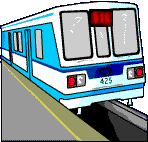The Beijing Mass Transit System
Created | Updated Jan 28, 2002

Apart from walking and cycling, there are two extremely inexpensive ways of getting around Beijing - the subway and buses. The utility of either of these modes of transit will not be readily apparent to a visitor, since the subways don't seem to go anywhere useful and the buses are incredibly difficult to understand. With determination, however, it's possible to get where you're going without resorting to taxis.
Philosophy
The subway system in Beijing consists of two lines. One, the more useful of the two, follows the Second Ring Road in a complete loop. Thus, even if you unwittingly get on a train going in the wrong direction, you will reach your stop eventually. Therefore, it's possible to take a generally relaxed approach to riding this line as long as you're not in any great hurry. The faster method is to identify where you are, where you want to go, and which direction will take you there in fewest stops. The directions on the subway are marked by the final destination the train is heading towards, so follow the map to the stop marked in the station and you should be able to work out what's going where.
The other line comes in from the Western suburbs and cuts through the southern part of the loop before continuing east. There is a section of this line on the map marked 'Under Construction', so the line doesn't actually go straight through the Second Ring line. As far as anyone can tell there has been no significant progress made on this small section of track for the last ten years, so plan accordingly. Most visitors will never have to use this line anyway.
Under no circumstances should you rely on the tannoy on any train for information about your current stop - the 'You have arrived at...' part is in very clear English, but the actual name of the stop will be unintelligible to anyone who doesn't already speak Chinese. Instead, make note of where you got on and count the stops to where you're going.
If you're wondering, the Second Ring Road is actually where the old Beijing City Wall used to be, so most of the subway stops are named after the old gates in the wall.
Relatively speaking, the subway is the fastest and cleanest way of getting around Beijing, but unfortunately it only goes as far as the Second Ring Road. To get to anything further out, you will have to use a bus. This is slightly more complicated. Bus stops almost always have their terminus at a subway stop, and they radiate out from there. To get from a point on one end of town to another, it is usually best to take a bus in to the nearest subway station, take the subway around to a stop nearer to your destination, and switch to another bus. It is highly inadvisable to attempt to get across town only by bus, unless you have a couple of days to spare.
To work out Beijing's transport complexities, you should first buy a good map of the city, almost all of these have the routes of the buses marked on them in small numbers. In all seriousness, a compass could also be a good thing as long as you don't mind looking totally lost, since Beijing is laid out in a grid along the cardinal points.
Practical Usage Suggestions
Transit in Beijing uses paper tickets instead of tokens or anything more expedient. In the subways, there will be a ticket window where you can purchase a ticket - under no circumstances should you attempt to wait in line to purchase a ticket unless you see Chinese people doing so. The concept of waiting in line hasn't penetrated very far into the Chinese mindset, and is generally perceived as a reason for everyone, including grandmothers and small children, to push ahead of you. The rule is, the first person to get their money onto the counter gets their ticket, and you should not feel bad about squeezing, shoving and weaselling to get yours. Your ticket will be collected by someone waiting by the entrance, who will rip it in two and throw one half away. Do not attempt to figure out why fares are paid in this manner - the obvious flaws suggest some important reason why tickets should be used, but there actually aren't any such reasons, and you'll just get a headache.
Buses also use tickets, which are dispensed at the front and the rear of the bus by two ticket attendants at little counters. It's important that you know the name of your stop and can pronounce it in something like passable Chinese, or the attendant will get very cross with you while you fumble with maps to show her (or, more rarely, him) where you're going. Having a literate friend write the name of the stop would also be good and once you've worked out where you're going, expect to pay a fare based on how far you go. Buses in Beijing tend to be ancient, and parts of many of them are actually made of wood. Don't be alarmed by this, or by the large, old rubber mid-sections that hold most buses together, this is completely normal. Seats are usually hard to come by and giving up seats to the old or infirm is a Chinese custom that most Beijingers would just as soon ignore, so if you have a chance to do this you should.
That about covers public transportation in Beijing. You're almost guaranteed to get lost the first couple of times that you try this, but fortunately everything runs on a fairly regular schedule and is very cheap, so mistakes won't cost you very much in time or money.

